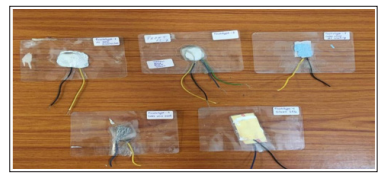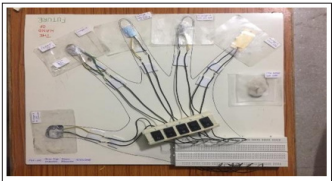Author(s): Seema Vats* and Aman Singh
In this era of ‘Smart technologies’ there is a demand for power generation using innovative eco- economical technologies. With increasing population, the use of electric power is also increasing. But we know that the resources are limited to generate electricity and this has led to the energy crisis. Under this scenario, we need to explore non-polluting eco-economical methods to generate electricity. To meet this, a smart material such as piezoelectric materials are subjects of extensive research and development and are continuously finding newer applications. The piezoelectric materials convert mechanical energy into electrical energy. Mechanical energy can be extracted from kinetic energy of vehicles, footsteps, wind currents, breathing etc. Presently, their diverse applications include flexible, biocompatible and energy efficient smart materials used as nanogenerators.
In this article we are reporting the making of a prototype using fish scales as piezoelectric material which can convert energy from surroundings like sound energy, wind currents etc into electrical energy. The energy converted to electrical energy can be used for charging of mobile phones lightning streets, portable medical devices etc. This will help reduce the bio-waste and produce new biocompatible nanogenerators which exhibit a feasible source of continuous power for various self- powered devices.
In this era of ‘Smart technologies’ there is a demand for power generation using innovative eco-economical technologies. With increasing population, the use of electric power is also increasing. But we know that the resources are limited to generate electricity and this has led to the energy crisis. Under this scenario, we need to explore non-polluting eco-economical methods to generate electricity. To meet this, a smart material such as piezoelectric materials are subjects of extensive research and development and are continuously finding newer applications. The piezoelectric materials convert mechanical energy into electrical energy
Mechanical energy can be extracted from kinetic energy of vehicles, footsteps, wind currents, breathing etc. Presently, their diverse applications include flexible, biocompatible and energy efficient smart materials used as nanogenerators. Wang et al have reported the ZnO nanowire as piezoelectric nanogenerators and are also biocompatible [1]. Similar work is reported by Qi. et al on Biocompatible and flexible energy harvesters that can be electromechanically coupled as nanopiezoelectric flexible devices for wearable or implantable applications [2]. Also, Mandal and Ghosh et al have reported fish scales acting as high-performance bio-piezoelectric nanogenerator [3].
In this article we are reporting the making of a prototype using fish scales as piezoelectric material which can convert energy from surroundings like sound energy, wind currents etc into electrical energy. The energy converted to electrical energy can be used for charging of mobile phones lightning streets, portable medical devices etc. This will help reduce the bio-waste and produce new biocompatible nanogenerators which exhibit a feasible source of continuous power for various self- powered devices.
To fabricate the BPNG, fish scales were collected and washed with water followed by a solvent system of NaOH NaCl HCl and EDTA to obtain almost transparent and flexible demineralized fish scales. Surface electrodes on the fish scales were made using different configurations followed by laminating it with common plastic lamination sheet to obtain the BPNG prototypes. The prototypes are shown in Figure 1-5. The size of a Fabricated BPNG is approx 5cm*5cm

Figure 1: Prototype-1 Figure 2: Prototype-2 Figure 3: Prototype-3

Figure 4: Prototype-4 Figure 5: Prototype-5
| Prototypes | Specifications | Max voltage (mV) |
|---|---|---|
| 1 | FS/AF/FS/AF/FS layered | 30 mV |
| 2 | AF/FS/AF/FS/AF/ FS/AF layered | 20mV |
| 3 | Non- conducting/FS/ Aluminium Coating layered | 10 mV |
| 4 | FS/WM/FS layered | 5 mV |
| 5 | Nonconducting/AF/ SF/FS/SF/AF/non -conducting layered | 7 mV |
FS- Fish Scale; AF- Aluminium Foil; WM-wire mesh; SF-Silver Foil
Table 1: Showing the specifications of all the prototypes with the maximum voltage output. The maximum voltages developed in the different sandwiched configurations on applying pressure are shown in the table 1. When there are alternate layers of Fish scales and conducting layer of aluminium foil, the voltage developed is maximum i.e. 30mv. It could be possible that the charge developed on pressing this prototype would add up to give maximum voltage. The voltage developed for layered structure consisting of nonconducting material, aluminium foil, silver foil and fish scale is minimum because the nonconducting layer does not add up the charge developed in sandwiched aluminium foil and fish scales. The deep learning is required to look into the mechanism responsible for producing voltage in the sandwiched configuration of conducting metal layer piezoelectric layer and non-conducting layer. We have tried to make a piezoelectric hand with all the possible configurations producing different voltages as shown in figure 1.2.

Figure 1.1: Picture showing prototype in the following order from top of the left corner; Prototype 1, Prototype 2, Prototype 3, Prototype 4, Prototype 5.

Figure 1.2: Piezoelectric Hand showing all the five prototypes
at the tip of the fingers.
You press the finger and get different voltages.
It is concluded that the BPNG made by fish scales converts the mechanical energy to electricity It can generate output voltage of value mV and potentially even higher Hence the Fish scale BPNG can be used to harvest several types of ambient mechanical energies such as body movements, machine and sound vibrations which are abundant in living environment The fish scale BPNG does not requires a complex fabrication process and it can be completely made out of the waste coming from our household (fish scales, aluminium foil, plasti c) Hence becoming a sustainable green power source for the generations to come and reducing the bio waste to a large extent.
Due to the small size of the BPNG fabricated, it can be used in various fields:
•These can be incorporated in the shoe sole that can be used to produce electricity while walking and running.
•These can be laid along the sea shore and harvest the energy produce by wave currents
•These can be laid beneath the floor of high security vaults to trigger the alarm.
•Piezoelectric hand can be used in toys to test the muscular strength. More is the pressure, then maximum value of voltage is displayed.
